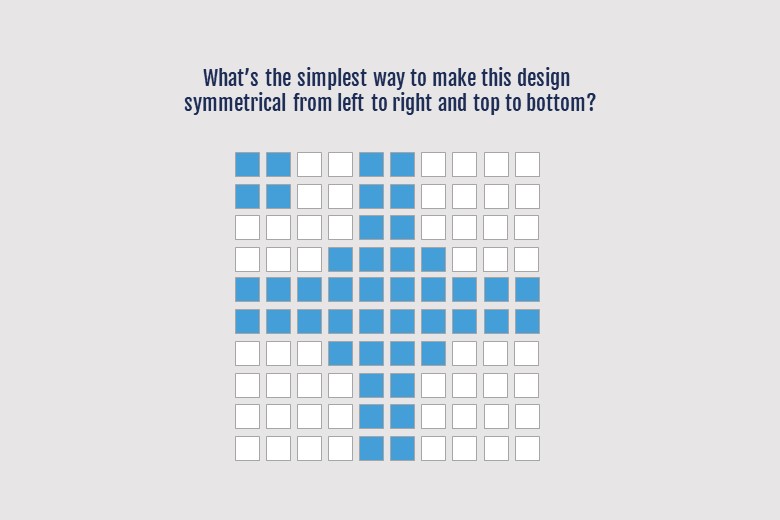Brilliantly simple invention designs – solving pain points in the simplest way. It’s in our DNA, it’s MAKO’s north star. But it’s not always the easiest approach. We understand what it’s like to dream big and get lost in extravagant thoughts of creating the invention that will finally do so many wonderful things and will help so many people. But how many inventors consider the engineering, designing, or manufacturing side of the process? Taking these things into consideration, you’ll start to develop questions about feasibility, cost efficiency, and marketability. These are questions that you’ll need to have answers for if you want to get your product onto store shelves or in the hands of investors.

It’s not entirely our fault though.
Consider the image above. What’s the simplest way to make this picture symmetrical? Before you continue reading, pause for a moment and make a mental note of what your instinctive answer was.
It’s one of the brain teasers the folks at Washington Post highlighted that’s part of a larger set of experiments published in Nature. Nature, the leading international weekly journal of science, recently published a paper pointing out how our brains are generally configured to add, rather than subtract when it comes to problem-solving.
So what’s the correct answer to this puzzle then? It’s not to add four blocks in each of the remaining corners. It’s to simply remove the first four in the top right corner!
It’s ok though, only 40 percent in the study answered correctly.
“It’s something that they don’t think about,” says co-author of this paper, Gabriella Adams, in a quote from the CBC. “So when they approach a problem, people tend to ask themselves, ‘What can I add?’ And they tend not to ask themselves, ‘What can I subtract? What can I remove or take away?”
When it comes to Invention Designs, Less is More
So how does one encourage this kind of thinking process to create a simple invention design?
In one of the other experiments, the researchers showed participants a Lego pillar with a roof that was only supported by a single Lego piece.
After dividing the participants into two groups, the researchers first asked the first group participants to stabilize this Lego roof with specific parameters. Participants who complete the task will earn one dollar but each Lego piece that’s added to the structure costs 10 cents.
- With this information, 40 out of 98 in this first group removed the single support piece allowing the roof to be fixed on the structurally sound pillar.
Along with the budget information above, the second group of participants was also told that removing pieces from the structure is free and costs nothing.
- With this information, 60 out of 99 in this second group removed the single support piece.
Amazing what a little extra information does to bring about simpler invention design thinking!

Conclusion
So let’s circle back to how this affects the ideation process. Why is it so important that it costs 10 cents to add a Lego piece to their experiment? Because it helps inventors see through the lens of other stakeholders in the product development process. It helps inventors realize that no invention is created without constraints. Whether it’s time, money, or materials, inventors need to be realistic about bringing their invention design to life. In the case of the Lego experiment above, it was money.
Propose an idea that’s too complex with too many features? Marketers may say it’s too confusing to identify the target audience and communicate the product’s key selling points. Engineers and designers may explain to you the mechanical or manufacturing obstacles. But this doesn’t mean you have a bad idea, it just means you need to simplify.
Do overthink it, go to your family and friends to get their honest feedback about your invention design. You can always come to us as well. Give us a shout and we’ll provide a free product consultation on the house!
About: MAKO Design + Invent is the original firm providing world-class consumer product development services tailored to startups, small manufacturers, and inventors. Simply put, we are the leading one-stop-shop for developing your physical product from idea to store shelves, all in a high-quality, cost-effective, and timely manner. We operate as one powerhouse 30-person product design team spread across 4 offices to serve you (Austin, Miami, San Francisco, & Toronto). We have full-stack in-house industrial design, mechanical engineering, electrical engineering, patent referral, prototyping, and manufacturing services. To assist our startup and inventor clients, in addition to above, we help with business strategy, product strategy, marketing, and sales/distribution for all consumer product categories. Also, our founder Kevin Mako hosts The Product Startup Podcast, the industry's leading hardware podcast. Check it out for tips, interviews, and best practices for hardware startups, inventors, and product developers. Click HERE to learn more about MAKO Design + Invent!







